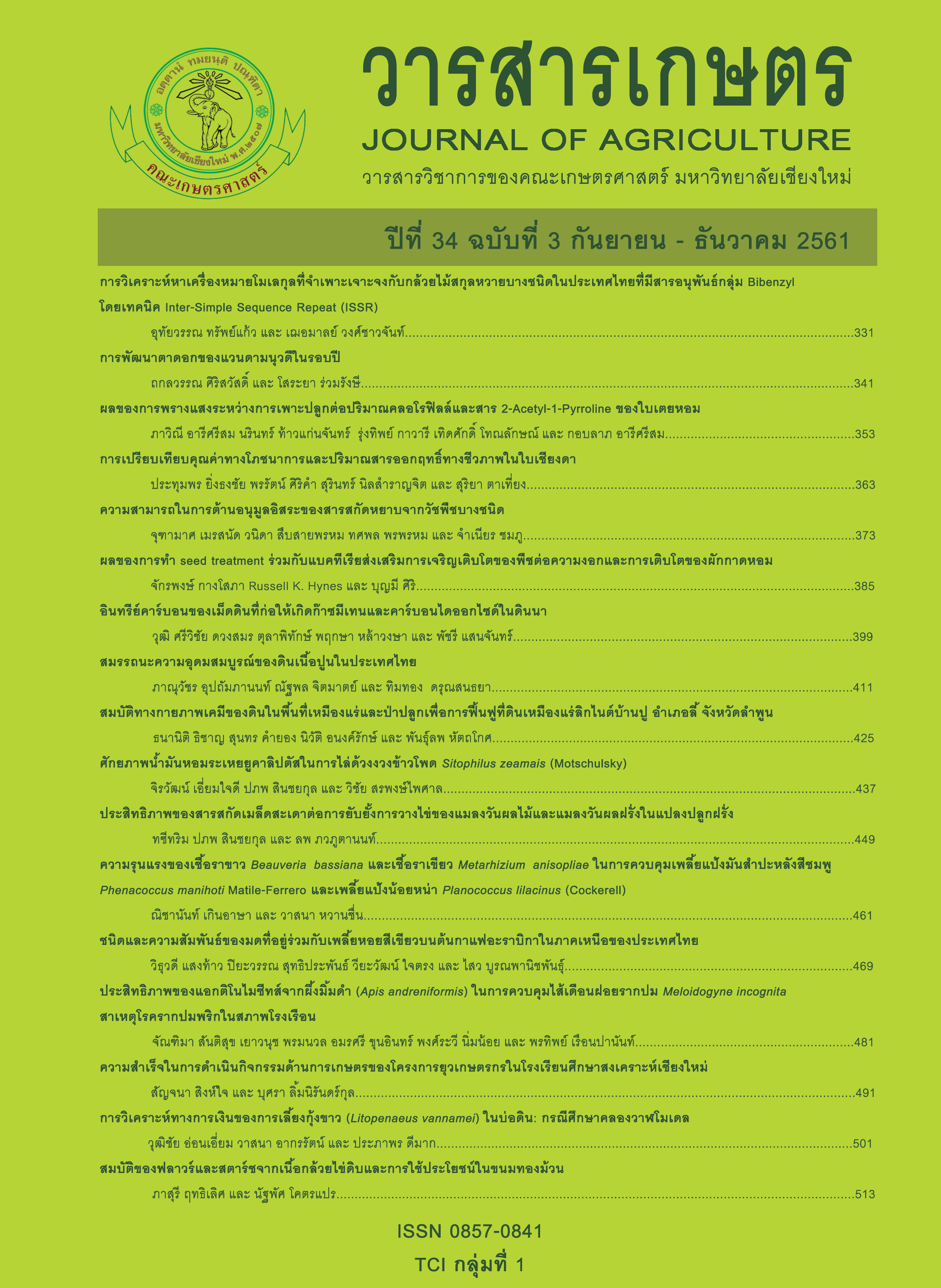การวิเคราะห์หาเครื่องหมายโมเลกุลที่จำเพาะเจาะจงกับกล้วยไม้สกุลหวายบางชนิดในประเทศไทยที่มีสารอนุพันธ์กลุ่ม Bibenzyl โดยเทคนิค Inter-Simple Sequence Repeat (ISSR)
Main Article Content
บทคัดย่อ
สารกลุ่ม bibenzyl ในกล้วยไม้สกุลหวายได้นำมาใช้ประโยชน์ทางด้านสมุนไพรในการป้องกัน และเป็นยารักษาโรคมากขึ้น การคัดเลือกลักษณะทางพันธุกรรมด้วยเทคนิคทางเครื่องหมายโมเลกุลเป็นอีกวิธีการที่สามารถช่วยร่นระยะเวลา และลดต้นทุนในการจำแนกกล้วยไม้สกุลหวายกลุ่มที่มีสารสำคัญต่าง ๆ ได้ งานวิจัยนี้มีวัตถุประสงค์เพื่อตรวจหาเครื่องหมายโมเลกุลที่จำเพาะเจาะจงกับกล้วยไม้สกุลหวายบางชนิดในประเทศไทยที่พบสารกลุ่ม bibenzyl โดยใช้เทคนิค ISSR จากการตรวจหาเครื่องหมายโมเลกุลที่จำเพาะเจาะจงกับกล้วยไม้สกุลหวาย 7 ชนิด ที่พบในประเทศไทยด้วยไพรเมอร์ ISSR จำนวน 96 ไพรเมอร์ พบว่ามีจำนวน 4 ไพรเมอร์จาก 10 ไพรเมอร์ ได้แก่ ไพรเมอร์ UBC-861, UBC-862, UBC-881 และ UBC-895 ที่สามารถสร้างแถบดีเอ็นเอที่แสดงความแตกต่างระหว่างกล้วยไม้สกุลหวายที่พบและไม่พบสารกลุ่ม bibenzyl จำนวน 4 แถบ โดยแถบดีเอ็นเอขนาด 350 คู่เบส ที่ได้จากไพรเมอร์ UBC-895 เป็นเพียงแถบเดียวที่สามารถวิเคราะห์ลำดับเบสได้ ผลการวิเคราะห์ลำดับเบสของแถบดีเอ็นเอ UBC-895_350 พบว่ามีขนาด 289 คู่เบส ลำดับเบสที่ได้มีความเหมือนกับ bibenzyl synthase-like ของกล้วยไม้ Dendrobium catenatum และ mRNA ของกล้วยไม้ D. catenatum ในฐานข้อมูล NCBI ดังนั้นจึงสามารถใช้เป็นข้อมูลเบื้องต้นในการพัฒนาเป็นเครื่องหมายโมเลกุลเพื่อใช้ในการจำแนกกล้วยไม้สกุลหวายต่อไป
Article Details
เอกสารอ้างอิง
ณัฐดนัย สุเมธาโชติพงศ์ กรวรรณ ศรีงาม วีณัน บัณฑิตย์ และ ณัฐา โพธาภรณ์. 2560. การวิเคราะห์องค์ประกอบของแอนโทไซยานิน และความสัมพันธ์ทางพันธุกรรมของดอกกล้วยไม้ช้าง. วารสารเกษตร 33(3): 311-321.
ยุพิน กสินเกษมพงษ์. 2558. โครงการวิจัยและพัฒนากล้วยไม้สกุล Dendrobium ที่มีศักยภาพเป็นสมุนไพร. รายงานความก้าวหน้าโครงการปี 2558. สถาบันวิจัยพืชสวน กรมวิชาการเกษตร, กรุงเทพฯ.
สุรินทร์ ปิยะโชคณากุล. 2552. เครื่องหมายดีเอ็นเอ: จากพื้นฐานสู่การประยุกต์. สำนักพิมพ์มหาวิทยาลัยเกษตรศาสตร์, กรุงเทพฯ. 269 หน้า.
Barra, M., E. Salazar, M. Beltrán and B. Sagredo. 2012. Simple and robust DNA extraction method for the large-scale analysis of genotypes containing high polyphenolic content, such as landraces of Solanum tuberosum and Zea mays. Ciencia e Investigación Agraria 39(3): 593-601.
Bhattacharyya, P., S. Kumaria and P. Tandon. 2015a. Applicability of ISSR and DAMD markers for phyto-molecular characterization and association with some important biochemical traits of Dendrobium nobile, an endangered medicinal orchid. Phytochemistry 117: 306-316.
Bhattacharyya, P., S. Kumaria and P. Tandon. 2015b. Phyto-molecular profiling and assessment of antioxidant activity within micropropagated plants of Dendrobium thyrsiflorum: a threatened, medicinal orchid. Plant Cell, Tissue and Organ Culture 122(3): 535-550.
Chen, X.M., F.F, Wang, Y.Q. Wang, X.L. Li, A.R. Wang, C.L. Wang and S.X. Guo. 2012. Discrimination of the rare medicinal plant Dendrobium officinale based on naringenin, bibenzyl, and polysaccharides. Science China Life Sciences 55(12): 1092-1099.
Doyle, J.J. and J.L. Doyle. 1987. A rapid DNA isolation procedure for small quantities of fresh leaf tissue. Phytochemical Bulletin 19(1): 11-15.
Hossain, M.M. 2011. Therapeutic orchids: traditional uses and recent advances-An overview. Fitoterapia 82(2): 102-140.
Kowitdamrong, A., P. Chanvorachote, B. Sritularak and V. Pongrakhananon. 2013. Moscatilin inhibits lung cancer cell motility and invasion via suppression of endogenous reactive oxygen species. BioMed Research International, doi: 10.1155/2013/765894.
Liu, Y. N., S. L. Pan, C.Y. Peng, D.Y. Huang, J. H. Guh, C.C. Chen, C.C. Shen and C.M. Teng. 2010. Moscatilin repressed lipopolysaccharide-induced HIF-1α accumulation and NF-κB activation in murine RAW264.7 cells. Shock 33(1): 70-75.
Porebski, S., L.G. Bailey and B.R. Baum. 1997. Modification of a CTAB DNA Extraction protocol for plants containing high polysaccharide and polyphenol components. Plant Molecular Biology Reporter 15 (1): 8-15.
Salzman, R.A., T. Fujita, K. Zhu-Salzman, P.M. Hasegawa and R.A. Bressan. 1999. An improved RNA isolation method for plant tissues containing high levels of phenolic compounds or carbohydrates. Plant Molecular Biology Reporter 17(1): 11-17.
Sanger, F., S. Nicklen and A.R. Coulson. 1977. DNA sequencing with chain-terminating inhibitors. Proceedings of the National Academy of Sciences of the United States of America 74(12): 5463-5467.
Sritularak, B. and K. Likhitwitayawuid. 2009. New bisbibenzyls from Dendrobium falconeri. Helvetica ChimicaActa 92(4): 740-744.
Sritularak, B., M. Anuwat and K. Likhitwitayawuid. 2011a. A new phenanthrenequinone from Dendrobium draconis. Journal of Asian Natural Products Research 13(3): 251-255.
Sritularak, B., N. Duangrak and K. Likhitwitayawuid. 2011b. A new bibenzyl from Dendrobium secundum. Zeitschrift für Naturforschung C 66(5-6): 205-208.
Tsai, A.C., S.L. Pan, C.H. Liao, J.H. Guh, S.W. Wang, H.L. Sun, Y.N. Liu, C.C. Chen, C.C. Shen, Y.L. Chang and C.M. Teng. 2010. Moscatilin, a bibenzyl derivative from the India orchid Dendrobrium loddigesii, suppresses tumor angiogenesis and growth in vitro and in vivo. Cancer Letters 292(2): 163-170.
Yang, L., Z. Wang and L. Xu. 2006. Simultaneous determination of phenols (bibenzyl, phenanthrene, and fluorenone) in Dendrobium species by high-performance liquid chromatography with diode array detection. Journal of Chromatography A 1104(1-2): 230-237.


